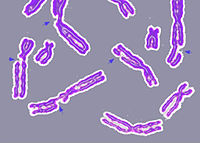
Photo from wikipedia
Reactive oxygen species generate some 20,000 base lesions per human cell per day. The vast majority of these potentially mutagenic or cytotoxic lesions are subject to base excision repair (BER).… Click to show full abstract
Reactive oxygen species generate some 20,000 base lesions per human cell per day. The vast majority of these potentially mutagenic or cytotoxic lesions are subject to base excision repair (BER). Although chromatin remodelers have been shown to enhance the excision of oxidized bases from nucleosomes in vitro, it is not clear that they are recruited to and act at sites of BER in vivo. To test the hypothesis that cells possess factors that enhance BER in chromatin, we assessed the capacity of nuclear extracts from human cells to excise thymine glycol (Tg) lesions from exogenously added, model nucleosomes. The DNA glycosylase NTHL1 in these extracts was able to excise Tg from both naked DNA and sites in nucleosomes that earlier studies had shown to be sterically accessible. However, the same extracts were able to excise lesions from sterically-occluded sites in nucleosomes only after the addition of Mg2+/ATP. Gel mobility shift assays indicated that nucleosomes remain largely intact following the Mg2+/ATP -dependent excision reaction. Size exclusion chromatography indicated that the NTHL1-stimulating activity has a relatively low molecular weight, close to that of NTHL1 and other BER glycosylases; column fractions that contained the very large chromatin remodeling complexes did not exhibit this same stimulatory activity. These results indicate that cells possess a factor(s) that promotes the initiation of BER in chromatin, but differs from most known chromatin remodeling complexes.
Journal Title: DNA repair
Year Published: 2017
Link to full text (if available)
Share on Social Media: Sign Up to like & get
recommendations!